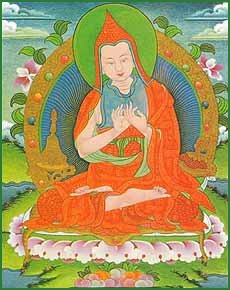The Great Chariot
by Longchenpa | 268,580 words
A Commentary on Great Perfection: The Nature of Mind, Easer of Weariness In Sanskrit the title is ‘Mahāsandhi-cittā-visranta-vṛtti-mahāratha-nāma’. In Tibetan ‘rDzogs pa chen po sems nyid ngal gso’i shing rta chen po shes bya ba ’...
Part 4a.1 - Meditation on the protection circles
Now we will enter into the details of meditation on the mandalas of samadhi. In a solitary and compatible place:
Sitting in cross-legged posture upon a comfortable seat,
Having taken refuge and aroused the bodhicitta,
Then from within the nature of simplicity,
Where dharmas all are empty, and ego does not exist,
The syllable HUM arises, then in turn from that,
Extending above and below, as well as in all directions,
The deployment of the protective circle is huge and vast.
Its ten spokes are adorned with the ten wrathful deities.
The circle is splendid with blazing fire within and without.
First, as for the preliminaries, sit cross-legged on a comfortable seat. Visualizing the guru and the assembly of deities of the yidam mandala in space, take the three refuges and as it is explained in the Precious Net of Peace (zhi ba rin po che’i dra ba):
Ourselves as well as limitless sentient beings,
Are in reality primordial buddhas,
By us who know that this is really so,
May supreme bodhicitta be aroused.
Having said that three times, with the “svabhava” mantra all dharmas are established as the great emptiness. This is the suchness samadhi. The Great Development and Completiom (bskyed rdzogs chen mo) says:
HUM
The pure nature, bodhicitta, is primordially unborn,
Eternally all-encompassing and limitless in its depth.
A non-existing, unperceivable state of simplicity,
Inexpressible beyond thought, a perfect space of equality.
The Very Important Heruka (he ru ka gal po che) says:
This without thoughts[1] is the great space, Dharmadhatu.
Dharmadhatu is space that without all thoughts.
This space of Dharmadhatu free from thoughts,
It is not perceived, as space is not perceived.
Meditate like that. From the state of dharmakaya is manifested the auspiciously related arising of rupakaya.[2] As after this all lesser productions are exhausted in the primordial empty nature of the great perfection, the knot of attachment to things and characteristics is necessarily untied. The Stages of the Pat(lam rim) says:
By emptiness all paths are marklessness.
Attachment to ego-grasping is liberated.
Then, in order to untie the knot of one-sided attachment to emptiness, there is meditation in the all- illuminating samadhi. The appearance of all dharmas is natureless. In a state of illusion-like compassion, meditate for a while on the natural luminous wisdom of self-awareness without grasping. The same text says:
Be familiar with the king of self-awareness,
And so this supreme enlightenment will be gained.
Therefore after the suchness of seeing this
Rest in the ground of arising of compassion.
Their rising in sequence like this is a certainty.
Then from the two sections on the cause samadhi, Previously to that there is the circle of what is to be guarded. Here from HUM, in limitless space whose entire expanses blazes with masses of flames, comes a ten spoked wheel. Between rim and center, in the empty space inside, which is equal to Dharmadhatu, the ten spokes are transformed into ten lotus, sun, and moon seats marked with HUM.
Above is Huumkara.
To the east is Vijaya (rnam par rgyal ba).
To the southwest Blue Danda (dbyug sngon can).
To the south is Yamantaka (gshin rje gshed).
To the southwest is Achala (mi gyyo ba.
To the west is Hayagriva (rta mgrin).
To the northwest is Not Attained by Others (gzhan gyis mi thub pa).
To the north is Amritakundalin (bdud rtsi ‘khyil ba).
To the northeast is All-Victorious in the Three Realms (khams gsum rnam rgyal),
Below is Mahabala (stobs po che).
Each of them has one face and two arms ornamented with all the supreme[3] and nirmanakaya ornaments The right leg is bent and the left extended. They hold scepters symbolizing their respective families or else a bell and vajra.
The two wrathful ones above and below, of the tathagata family, hold wheels.
Those to the east and southeast, of the vajra family, hold black and white vajras.
Those to the south and southwest, of the ratna family, hold dark yellow gems.
Those to the west and northwest, of the padma family, hold dark red eight petaled lotuses.
Those to the north and northeast, of the karma family, hold dark green crossed vajras and swords.
In the extensive version, there are the lady tramens with three heads and six arms
Their six feet are on the seats of the protectors of the ten directions. Each has the symbol indicating the one to which she belngs among the five families, as well as the “increase” and so forth. These should be learned about elsewhere.
As for the main topic, the cause samadhi: The palace, may be visualized or not, as appropriate. Having meditated on oneself briefly as the chief deity, while thinking of the deity as empty, in this case it is joined with the meditation of the seed syllable from which the deity is visualized.
Footnotes and references:
[1]:
[2]:
[3]:
